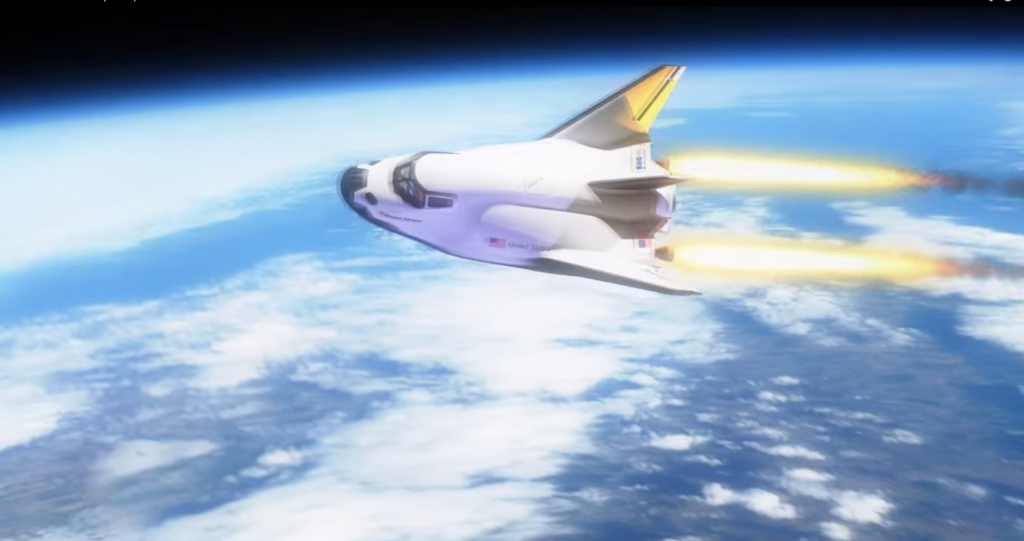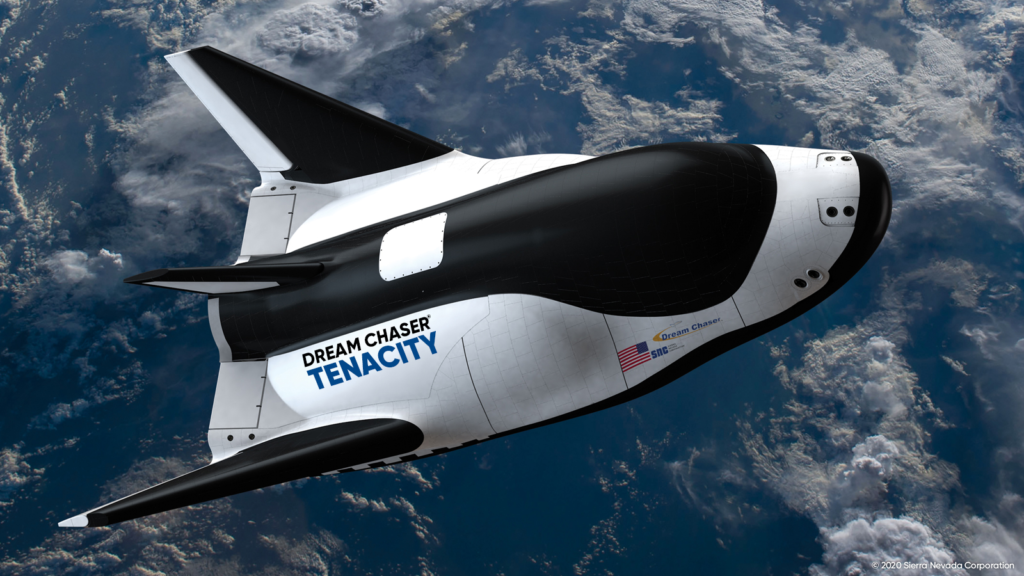
A Closer Look At Dream Chaser Tenacity’s Two Main Engines
Dream Chaser is scheduled to lift off for the first time in the third quarter of this year. This long awaited mission will be the first test of a handful of different systems. This includes the heat shield, rocket body, thrusters, and main propulsion, just to name a few. All of which will be put to the test with a mission profile that takes Dream Chaser Tenacity to the International Space Station and back for a runway landing.
One of the most important yet often overlooked components of Dream Chaser is its two main engines on the rear of the spacecraft. While unlike the Space Shuttle, these won’t be used during liftoff, they will help Dream Chaser get into its operational orbit depending on the mission profile. It’s important to point out however that the Vortex Engine has yet to be flown in space.
Originally, on-orbit propulsion of the Dream Chaser was proposed to be provided by twin hybrid rocket engines capable of repeated starts and throttling. This was before an acquisition by the company all the way back in 2014. Here I will go more in-depth into the primary Dream Chaser propulsion system, what this looks like on Tenacity, what to expect in the coming months, and more.
Dream Chaser Engines

Days ago on the 14th Sierra Space tweeted saying, “Our VR35K-A upper stage VORTEX engine, developed in conjunction with the Air Force Research Laboratory, provides 35,000 lbf thrust and high specific impulse using liquid oxygen and liquid hydrogen for increased launch capability and reusability.” Two of these engines are used on the back side of Dream Chaser with the spacecraft’s main access hatch in between.
Originally, on-orbit propulsion of the Dream Chaser was proposed to be provided by twin hybrid rocket engines capable of repeated starts and throttling. At the time, SNC Space Systems was also developing a similar hybrid rocket for Virgin Galactic’s SpaceShipTwo. However, in May 2014, SNC’s involvement in the SpaceShipTwo program ended. After the acquisition of Orbitec LLC in July 2014, Sierra Nevada Corporation announced a major change to the propulsion system. The hybrid rocket engine design was dropped in favor of a cluster of Orbitec’s Vortex engines.
The VORTEX engine thrust chamber assembly confines propellant mixing and burning to the core region of a coaxial vortex flow field. The goal here is to try and enable dramatic cost savings through robust design margins which could lead to extremely high durability, reliability, and reusability in engines that are inexpensive to manufacture and maintain. The coaxial vortex flow field is also applicable to hybrid rocket engine systems to produce fuel regression rates significantly higher than conventional hybrid configurations. This increase in fuel regression rate enables the use of a simple circular grain port, conferring significant gains in performance, reliability, and durability of hybrid systems. All this being said, the VORTEX engine has still yet to be put to the real test in space.
Back in 2020, SNC reached a major milestone in the advancement of hypersonic propulsion with its VORTEX engine, advancing to the next phase of the Defense Advanced Research Projects Agency’s (DARPA) Operational Fires (OpFires) program. The testing showed positive results in being able to package significant energy into a small volume that will have the ability for deep throttling and smooth restart capabilities on command. “The VORTEX flows integrated into the hybrid significantly improves performance of the hybrid engine” said the director of Propulsion Systems at SNC. “This program opens up a new market for SNC for preplanned or on-demand propulsion control capabilities that are applicable to both military and beyond Earth orbit propulsion capabilities,” said the vice president of SNC’s Propulsion & Environmental Systems business unit. “Deep throttling and restart capabilities expand the tools for smart and unpredictable trajectories for various vehicles and systems.”
While Dream Chaser is a big part of this program, SNC plans to offer these engines to a variety of different customers in the future assuming they perform as expected. The upcoming launch of Dream Chaser will be a big first step and mark a major milestone in many areas if successful.
Tenacity’s First Mission

Now that we know more about Dream Chaser’s main engines and some of their past testing, we can take a closer look at the upcoming launch and what progress has been made. As of right now, the first Dream Chaser mission with Tenacity is still scheduled for the third quarter of this year. Based on progress from the different companies involved, it looks like this launch date is still realistic however there are some important factors to consider. On this first launch, Tenacity will sit within United Launch Alliance’s Vulcan rocket fairings.
Focusing on Sierra Space and Tenacity first, the company has not said very much recently regarding its progress. The last update we got was one month ago in the middle of January in a company report. It was quoted saying, “The first Dream Chaser, Tenacity, is nearing completion and will subsequently ship to NASA’s Neil Armstrong Test Facility in Cleveland, Ohio, for final space environmental testing ahead of its first mission to the ISS later this year.” We will likely receive an update when this shipment has happened which means that Tenacity could still be under construction. By now the thousands of thermal tiles should be installed since this process started months ago. Assuming Tenacity is shipped within the next couple of weeks to the test facility and the results are promising, it should be right on schedule for a launch later this year.
ULA on the other hand has quite a bit of work left. The first Dream Chaser mission is set to happen during the second ever Vulcan launch. The first launch of Vulcan is only months away as the vehicle has finished stacking and will soon complete final tests. Integrated testing of the rocket stages, VLP and ground systems will be conducted within the VIF over the next few weeks before Vulcan rolls out to Space Launch Complex (SLC)-41 to undergo a series of fuel-loading and countdown exercises. The testing culminates with a Flight Readiness Firing (FRF) to practice the full day-of-launch timeline complete with a brief ignition of the rocket’s main engines. With all this in mind, a launch in March or early April seems realistic.
In order for Dream Chaser’s mission to go well, this first Vulcan launch will need to be successful. If something were to go wrong ULA would not be in a position to launch again just months later with Tenacity on top. They would need to figure out exactly what went wrong and make changes accordingly. The next Vulcan will also require a new shipment of BE-4 engines from Blue Origin and a completed rocket as well.
While possible to do it on time, there is a lot of work that both Sierra Space and ULA need to complete in a short period of time. This is part of the problem with using a brand new rocket and spacecraft together on a mission. Initial missions often feature a lot of delays and even major issues which neither company obviously wants.
Focusing back on Tenacity, the spaceplane will not only utilize two main engines for the majority of thrust, but also tens of individual thrusters all along its body. In total, Dream Chaser will feature 26 reaction control system thrusters across the entire spaceplane. This includes 6 on the back of Shooting Star forming somewhat of a large circle, 6 on either side of the back of Dream Chaser, and 8 more at the very front of the spaceplane. In comparison, the Space Shuttle Orbiter had a lot of thrusters, which were required to control vehicle attitude in both orbital flight and during the early part of atmospheric entry, as well as carry out rendezvous and docking maneuvers in orbit. Shuttle thrusters were grouped in the nose of the vehicle and on each of the two aft Orbital Maneuvering System pods. No nozzles interrupted the heat shield on the underside of the craft; instead, the nose RCS nozzles which control positive pitch were mounted on the side of the vehicle, and were canted downward. The downward-facing negative pitch thrusters were located in the OMS pods mounted in the tail/afterbody. Altogether there were 38 primary RCS jets on the Shuttle.
As far as the thrusters application to Dream Chaser, its first mission is a perfect example. Under NASA’s Commercial Resupply Services 2 (CRS-2) contract, Dream Chaser will provide a minimum of seven cargo service missions to and from the space station. On the first mission, Dream Chaser Tenacity is expected to dock with the International Space Station. This process involves extreme accuracy and precision which is exactly what all of these thrusters are intended for.
In the grand scheme of things, the Dream Chaser spaceplane is a multi-mission vehicle capable of supporting a variety of LEO needs. It can be customized for both domestic and international customers via vehicle configuration, launch site, destination, landing site, duration, and a host of other variables. Sierra Space has entered into agreements with multiple international space agencies. Together they are developing technologies, applications, and missions for Dream Chaser-based space systems. Something we can look forward to very soon.
Conclusion
Sierra Space is closing in on the first launch of Dream Chaser. For over a decade, this spaceplane has been under development, going through testing, and is now almost ready for an actual mission. In order to launch on time in the third quarter of this year, both Sierra Space and ULA will need to work quickly. We will have to wait and see how it progresses and the impact it has on the space industry.
